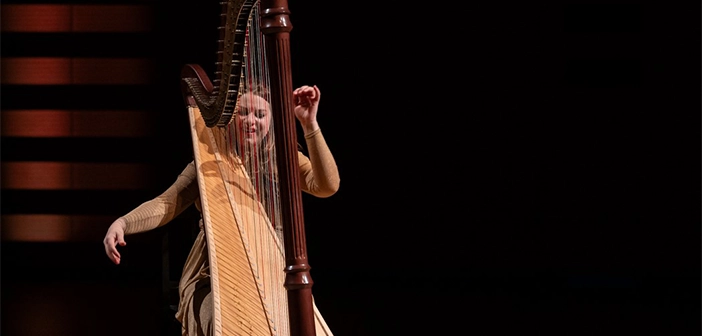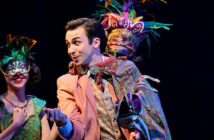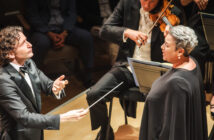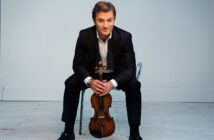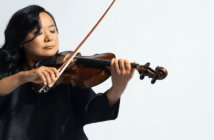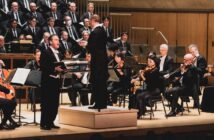There are times when concert programming becomes predictable and boring. Symphony concerts, recitals, chamber music events are all frequent offenders. So it was with great interest that I approached a Koerner Hall concert in Toronto this past Sunday, Jan. 21 that showed a refreshing departure from that tradition.
It featured harpist Bridget Kibbey along with the Calidore String Quartet. For good measure, Mervon Mehta, the Executive Director of Performing Arts at Koerner Hall appeared as narrator. The combination of performers was unusual but so too was the programming. There were solo harp pieces by Bach, Debussy, Fauré and Albeniz, a work by American composer Jesse Montgomery, and two works for harp and string quartet. One of them was the world premiere of Ongoingness by Sebastian Currier, and the other was a work from 1923 by French composer André Caplet. However, while the programming was promising the quality of the concert itself was variable.
The longest work on the program and by far the most absorbing was the Caplet, a piece inspired by Edgar Allan Poe’s story The Masque of the Red Death. Caplet’s score lasts about half and hour, it is purely instrumental and it is by no means a step by step realization of Poe’s story. Listeners should note that the composer called it Conte fantastique for harp and string quartet (after E.A. Poe The Masque of the Red Death). Presumably, in the interest of helping the audience understand what the music was about, Mervon Mehta, appearing as Poe himself complete with black mustache, read the story before the music was played. But it was more than a mere recitation. The stage was entirely dark except for a light on Mr. Mehta’s face. Before he spoke we heard loud thunderclaps. While he read the story panels of lights in various colours appeared behind him representing the variously coloured rooms of Prince Prospero’s castle in the story. At the end we heard more thunderclaps as Mr. Mehta finished reading. Then, without pause, came the performance of the Caplet.
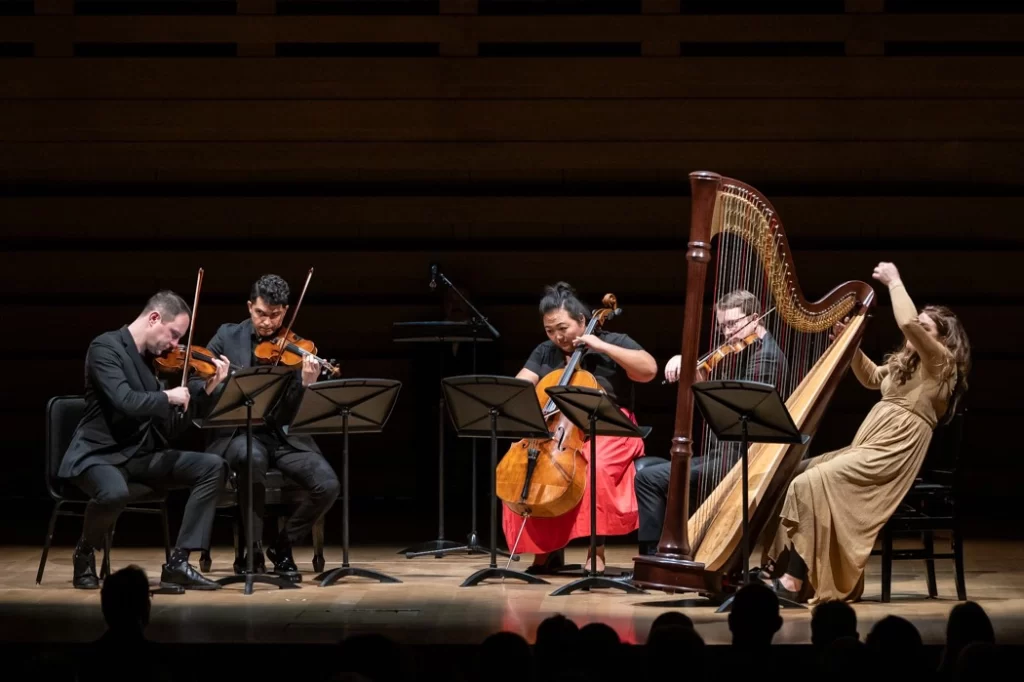
Bridget Kibbey with the Calidore String Quartet (Photos courtesy of The Royal Conservatory of Music/Koerner Hall; Lisa Sakulensky)
The theatrics were certainly appropriate to the telling of Poe’s gothic tale. The Masque of the Red Death tells the story of Prince Prospero who gathers all his noble followers in his castle then locks them all inside for their own protection against the plague which is ravaging the world outside. This plague is so terrible that victims succumb within half an hour. The Prince and his guests amuse themselves with music and dancing until the clock strikes twelve and a stranger appears in their midst. He is the Red Death and before long the Prince and everyone else who comes close to the mysterious figure is infected and dies. As the last line of the story tells us “And Darkness and Decay and the Red Death held illimitable dominion over all.”
It is certainly a good idea to read the story before listening to Caplet’s piece. Unfortunately, there are hardly any signposts in Caplet’s score to indicate what the music is supposedly telling us. At one point we hear the clock striking midnight but otherwise the music is certainly creepy and chromatic enough to accompany a horror film but nonetheless too abstract to clarify any other details of the story. Caplet uses all sorts of unusual effects in the strings such as playing with the nails or with the wood of the bow and these effects did indeed add to the gothic ambiance. But while the harp was offered plenty to do, little of it seemed to have much to do with Poe’s story. It should be mentioned that the harp was given one special effect: at one point in the score, just before the clock strikes twelve, the harpist hits the soundboard of her instrument about 10 times. What does it mean? I have no idea even after checking the printed score.
It is true that there are plenty of symphonic poems that purport to tell a story e.g. Tchaikovsky’s Romeo and Juliet or Strauss’s Till Eulenspiegel and they are often very effective in doing so. Perhaps it should have been made clearer to the Koerner Hall audience that Caplet’s piece was only inspired by Poe’s The Masque of the Red Death and was not attempting to provide a musical version of it. The performance by the Calidore String Quartet and harpist Bridget Kibbey was quite good. However, a performance featuring the Allegri Quartet is available on YouTube and it is much more exciting. Considering the theatrical nature of the Koerner Hall presentation it might have had more presence and impact had electrical amplification been used. Years ago Mr. Mehta was very active as an actor, appearing in more than 100 productions. He gave up acting in 1994 to devote himself exclusively to music administration. On the basis of his performance reading The Masque of the Red Death his acting chops are just a little rusty.
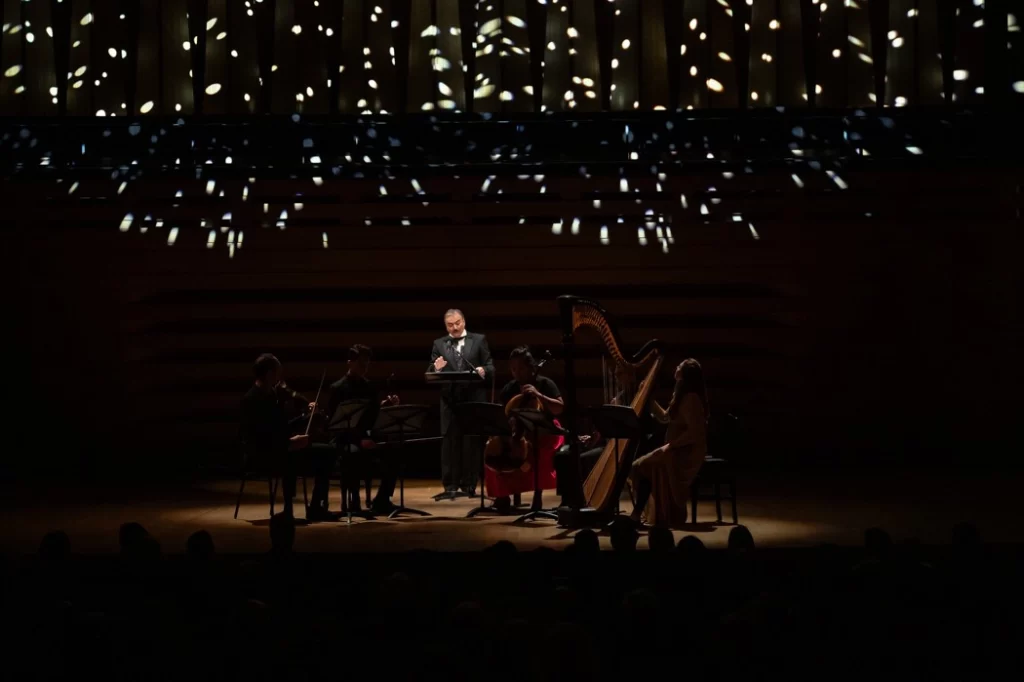
Calidore String Quartet at Koerner Hall, Jan. 21 (Photos courtesy of The Royal Conservatory of Music/Koerner Hall; Lisa Sakulensky)
The concert began with music for solo harp in the form of transcriptions of music by Bach, Debussy and Fauré. The American harpist Bridget Kibbey is a brilliant performer with vast experience. But why did she begin with the Toccata from Bach’s famous organ piece the Toccata and Fugue in D minor BWV 565? As almost everyone knows this is music of enormous strength and power with rolling organ chords that are enough to make your hair stand on end. On the harp, not so much. Later on Kibbey played her own transcriptions of two pieces by Albeniz. Here she was on more solid ground playing piano music that sounds well on several other instruments such as guitar and harp. Kibbey provided introductory comments for all her performances and she was both informative and amusing.
However, there were no introductory comments for Jesse Montgomery’s Strum and it could have used them. And since this work came well into the concert and the audience was in darkness the whole time there was no opportunity to refer to the program notes. In the notes the composer tells us that “the piece has a kind of narrative that begins with fleeting nostalgia and transforms into ecstatic celebration.” There was certainly lots of rhythmic energy in the music from time to time but otherwise Strum did not seem especially compelling.
Before intermission came Sebastian Currier’s Ongoingness in its world premiere performance. Like the Caplet it is a work for String Quartet and Harp, a sort of companion piece, if you will, for the Caplet work .Currier himself appeared on stage to make introductory comments. The title of the piece is taken from a book by the composer’s friend Sarah Manguso and in musical terms it means that thematic ideas are continually morphing throughout the piece. Unfortunately, the musical ideas did not strike me as interesting enough to justify the length. And André Caplet gave his harpist far more to do in his piece.
It was a pleasure to hear Bridget Kibbey although I would have preferred to hear her play more original music for the instrument. I also enjoyed getting to know Caplet’s Conte fantastique in the first live performance of it I have ever heard. And it is well worth hearing. Thanks to Bridget Kibbey, the Calidore String Quartet and Mervon Mehta for bringing it to us, and for a worthy attempt to do justice to both Caplet and Poe.
Calidore String Quartet
https://www.calidorestringquartet.com/Koerner Hall
https://www.rcmusic.com/performance/

